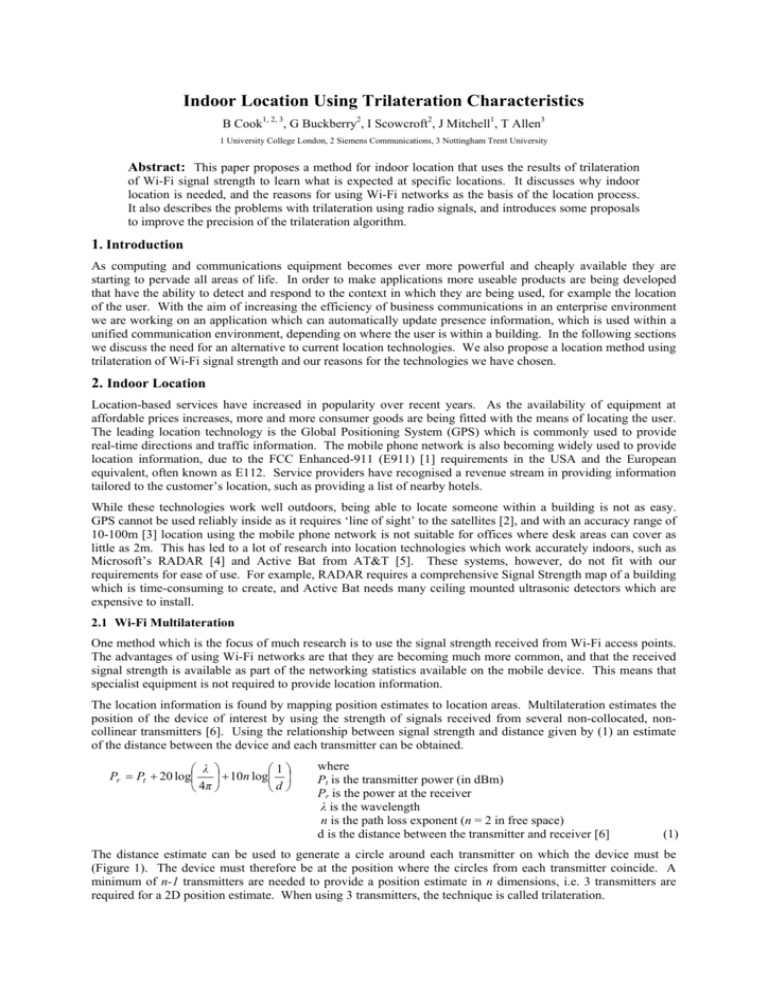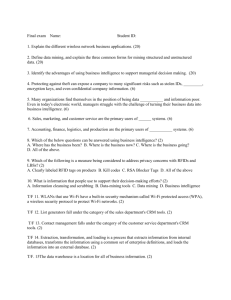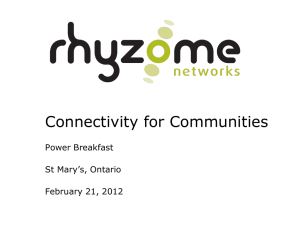Indoor Location Using Trilateration Characteristics
advertisement

Indoor Location Using Trilateration Characteristics B Cook1, 2, 3, G Buckberry2, I Scowcroft2, J Mitchell1, T Allen3 1 University College London, 2 Siemens Communications, 3 Nottingham Trent University Abstract: This paper proposes a method for indoor location that uses the results of trilateration of Wi-Fi signal strength to learn what is expected at specific locations. It discusses why indoor location is needed, and the reasons for using Wi-Fi networks as the basis of the location process. It also describes the problems with trilateration using radio signals, and introduces some proposals to improve the precision of the trilateration algorithm. 1. Introduction As computing and communications equipment becomes ever more powerful and cheaply available they are starting to pervade all areas of life. In order to make applications more useable products are being developed that have the ability to detect and respond to the context in which they are being used, for example the location of the user. With the aim of increasing the efficiency of business communications in an enterprise environment we are working on an application which can automatically update presence information, which is used within a unified communication environment, depending on where the user is within a building. In the following sections we discuss the need for an alternative to current location technologies. We also propose a location method using trilateration of Wi-Fi signal strength and our reasons for the technologies we have chosen. 2. Indoor Location Location-based services have increased in popularity over recent years. As the availability of equipment at affordable prices increases, more and more consumer goods are being fitted with the means of locating the user. The leading location technology is the Global Positioning System (GPS) which is commonly used to provide real-time directions and traffic information. The mobile phone network is also becoming widely used to provide location information, due to the FCC Enhanced-911 (E911) [1] requirements in the USA and the European equivalent, often known as E112. Service providers have recognised a revenue stream in providing information tailored to the customer’s location, such as providing a list of nearby hotels. While these technologies work well outdoors, being able to locate someone within a building is not as easy. GPS cannot be used reliably inside as it requires ‘line of sight’ to the satellites [2], and with an accuracy range of 10-100m [3] location using the mobile phone network is not suitable for offices where desk areas can cover as little as 2m. This has led to a lot of research into location technologies which work accurately indoors, such as Microsoft’s RADAR [4] and Active Bat from AT&T [5]. These systems, however, do not fit with our requirements for ease of use. For example, RADAR requires a comprehensive Signal Strength map of a building which is time-consuming to create, and Active Bat needs many ceiling mounted ultrasonic detectors which are expensive to install. 2.1 Wi-Fi Multilateration One method which is the focus of much research is to use the signal strength received from Wi-Fi access points. The advantages of using Wi-Fi networks are that they are becoming much more common, and that the received signal strength is available as part of the networking statistics available on the mobile device. This means that specialist equipment is not required to provide location information. The location information is found by mapping position estimates to location areas. Multilateration estimates the position of the device of interest by using the strength of signals received from several non-collocated, noncollinear transmitters [6]. Using the relationship between signal strength and distance given by (1) an estimate of the distance between the device and each transmitter can be obtained. ⎛1⎞ ⎛ λ ⎞ Pr = Pt + 20 log⎜ ⎟ + 10n log⎜ ⎟ ⎝d ⎠ ⎝ 4π ⎠ where Pt is the transmitter power (in dBm) Pr is the power at the receiver λ is the wavelength n is the path loss exponent (n = 2 in free space) d is the distance between the transmitter and receiver [6] (1) The distance estimate can be used to generate a circle around each transmitter on which the device must be (Figure 1). The device must therefore be at the position where the circles from each transmitter coincide. A minimum of n-1 transmitters are needed to provide a position estimate in n dimensions, i.e. 3 transmitters are required for a 2D position estimate. When using 3 transmitters, the technique is called trilateration. With perfect information this method will give an exact, unique answer, i.e. the single point at the intersection of the circles in Figure 1a. With imperfect information the circles will not intersect at a single point, in fact the circles may not intersect at all. In this situation an estimate of the position is found by looking for the point that simultaneously minimises the distance to all circles (Figure 1b), for example by using mathematical techniques such as Least Square Estimation (LSE) [6]. Radio signals are extremely variable, particularly indoors, due to being reflected by obstacles or refracted round corners – known as multipath reflection. Environmental changes can also affect the signals, such as the number of people around. This means that the positioning technique is inherently inaccurate, with positions from raw Wi-Fi signals being in excess of 10m out. b) a) Figure 1 Position estimation by trilateration a) perfect information b) imperfect information 3. Location Verification – A ‘Learn and Verify’ Application Although many applications require accurate position estimates, our Automated Presence application is interested only in a topological representation of the working environment. Also, our application does not need to know the location of the user at all times – it is only interested in when the user is in particular locations (Figure 2). Meeting Room 1 Meeting Room 2 position (x1,y1) position (x2,y2) My Desk Areas of interest Figure 2 Example showing the concepts of a topological representation of an indoor environment, and how position differs from location. Also shows that not all locations need to be known. In order to investigate the performance of the trilateration algorithm under ‘noisy’ conditions we developed a computer simulation. To simulate raw signal strength readings we used the propagation equation (1) to which we added a random normal error with mean=0 and variance=0.71d where d is the distance calculated by (1). This error model is based on analysis of the variation in radio propagation experiments. By tracking the cumulative average of the position estimate we saw that after many estimates (around 300) the average stabilised. In many of our trials this stabilised average was very close (approximately 1m for the trials shown in Figure 3) to the true position. We also saw that repeated trials gave similar results (Figure 3). Based on this we are developing an application which can recognise the RSSI signature and the characteristics of the position estimation procedure at known locations. This will circumvent the inaccuracy of the position estimation as the application does not need to use the estimate as an absolute position but as an expected value. The application will use a training phase to learn what to expect at a specified location, using characteristics such as the mean and variance of the signal strength from each Wi-Fi access point at that location, and the mean and variance of the position estimate over a number of iterations. During a verification phase, the application will compare real-time position estimates to these ‘expected’ characteristics of each known location. Test 1 Test 2 60 60 50 50 40 40 30 30 20 20 10 10 -3 0 -10 10 30 50 70 90 -30 -10 10 30 50 70 90 Estimates Average after 300 estimates test 1 test 2 mean x y 40.0861 31.19363 39.88042 30.93045 standard deviation x y 11.01462 5.408375 11.67773 5.686319 Figure 3 Simulation results show the similarity of repeated trials at the same location 4. Improving Trilateration Precision The application will initially perform the trilateration calculations using raw signal strength measurements, allowing us to evaluate the standard precision of the ‘learn and verify’ technique. However, due to the variation we observed in raw signal strength (Figure 4) and the results of our simulations (Figure 3) we expect low precision in position estimations and so we have considered ways to improve it. We have shown through simulation and radio propagation experiments that simple averaging can significantly reduce variation. 4.1 Averaging Signal Strength We have performed experiments to measure signal propagation over distance using both Wi-Fi signals and raw carrier signals generated in the 2.4GHz band. As we are interested in the repeatability of position estimates, rather than the accuracy, we looked at how quickly the average signal stabilised. The Wi-Fi experiment consisted of taking 100 readings at each of 4 locations. Although the amount of variation in signal strength was different for each position we found that the cumulative average stabilised after about 40 measurements (Figure 4). Preliminary tests on a PDA show that it would take approximately 42 seconds to take 40 readings, which would limit location updates to approximately once per minute. This should be sufficient as we would expect users to remain in one location for longer than this. Position 1 Position 2 -39 -42 1 11 21 31 41 51 61 71 81 91 -41 1 11 21 31 41 51 61 71 81 91 61 71 81 91 -43 -47 -45 -52 -49 -57 -53 -47 -51 -55 -57 -62 -59 Position 3 Position 4 -59 -50 -52 1 11 21 31 41 51 61 71 81 91 -61 -54 -63 -56 -65 -58 -67 -60 -69 1 11 21 31 41 51 -71 -62 -64 -73 -66 -75 -68 -77 -70 -79 Signal Strength reading Average Signal Strength Figure 4 Graphs of Signal Strength readings for Wi-Fi experiments, showing average signal strength stabilising after about 40 measurements 4.2 Averaging Position Estimate Using the simulation discussed in Section 3 we also looked at how taking a running average of a small number of estimates affects the spread of the results. We found that averaging 4 estimates significantly decreased the variation in the position estimates and significantly reduced the mean and variance of the distance between each estimate and the true position (Figure 5). Test 1 Test 2 60 60 50 50 40 40 30 30 20 20 10 -30 -10 10 10 30 50 70 90 -30 -10 10 30 50 70 90 Raw estimate Averaged estimate Actual position test 1 test 2 raw estimates mean variance 9.625864 7.883475 9.244069 8.483779 averaged estimates mean variance 2.176454 1.229834 1.474762 1.189049 Figure 5 Simulation results show the difference in spread caused by averaging position estimates 5. Conclusions The ability for Unified Communications solutions to have access to a user’s location indoors is increasingly important in the development of context-aware applications that increase business efficiency. The leading technologies (GPS and mobile networks) are not suitable for use within buildings, so we propose a system using trilateration of Wi-Fi signal strength. Although this is generally problematic, we believe that the advantages of widespread use of Wi-Fi networks make it worthwhile investigating. We suggest using the position estimate generated by the trilateration algorithm as a characteristic of a location rather than an absolute position. We hope to use this ‘expected’ position to recognise pre-known locations and are investigating the use of pattern matching techniques, such as Fuzzy Logic to allow us to associate live data with the stored results. References [1] FCC Enhanced 911 regulations, http://www.fcc.gov/911/enhanced/ [2] G M Giaglis, “On the Potential Use of Mobile Positioning Technologies in Indoor Environments”, 15th Bled Electronic Commerce Conference, 2002 [3] G M Giaglis, P Kourouthanassis, A Tsamakos. “Towards a classification framework for mobile location services”, “Mobile Commerce: Technology, Theory, and Applications”, Idea Group Publishing, 2002 (B E Mennecke and T J Strader, editors) [4] P Bahl, V N Padmanabhan, “RADAR: An In-Building RF-Based User Location and Tracking System”, Microsoft Research [5] A Ward, A Jones, A Hopper, “A New Location Technique for Active Office”, IEEE Personal Communications, Vol 4, No 5, Oct 1997 [6] G L Stüber, J J Caffrey, “Radiolocation Techniques”, “The Mobile Communications Handbook, 2nd Edition”, CRC Press, 1999 (J D Gibson editor)






